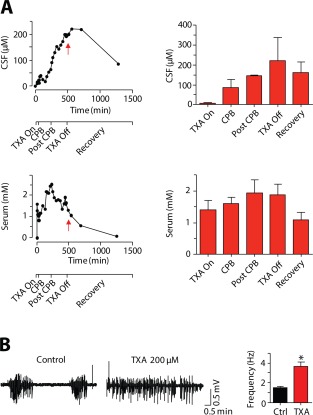Figure 1.

Tranexamic acid (TXA) concentrations measured in the cerebral spinal fluid (CSF) and serum of patients cause hyperexcitability in vitro. (A) The time course of TXA levels in the CSF and serum of 1 patient who experienced a seizure is shown on the left. The decline of TXA levels in the brain lags behind that in the blood. The timeline at the bottom of each figure indicates key surgical events during cardiopulmonary bypass (CPB). The red arrow highlights the concentrations when TXA administration was terminated. On the right are the summarized data of TXA concentrations in the CSF and serum during key surgical events (n = 4). TXA levels in the serum (2mM) are 10‐fold higher than those in the CSF (200 µM). (B) Clinically relevant concentration of TXA (200 µM) causes hyperexcitability by increasing the frequency of seizure‐like events in neocortical slices. *P < 0.05.
